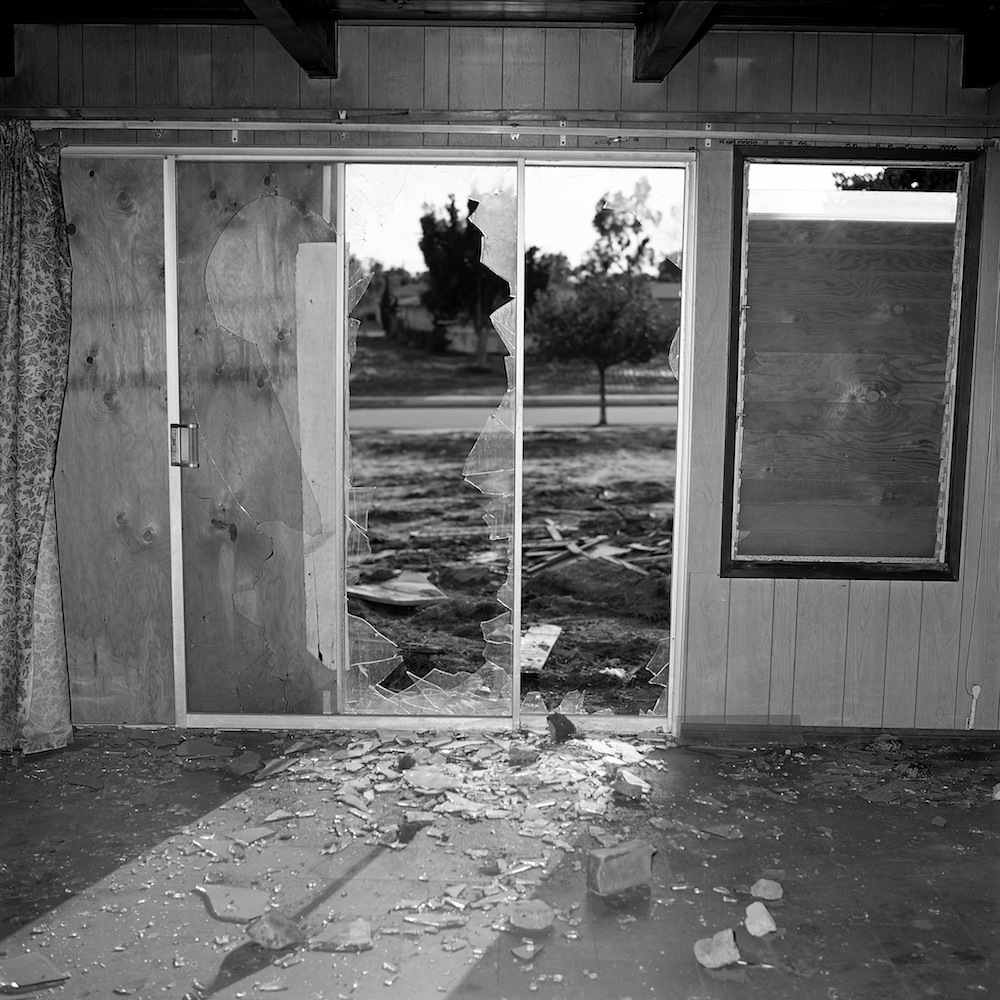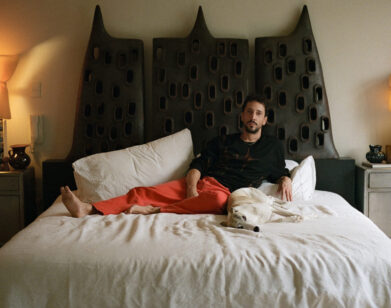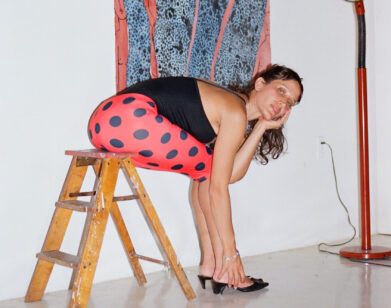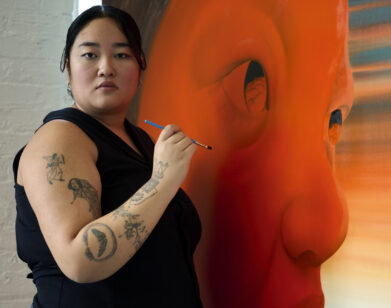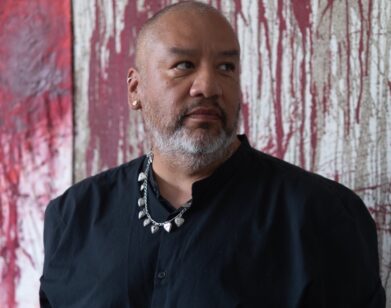John Divola’s Floating Eye
For John Divola, photography works as a transcendental medium. It does not merely document, or serve as an unflinching eye, but yields potential for a full-bodied exploration of perception and performance, playing with the construct of the photographic process. Divola has been creating images for over 40 years, working and living in Southern California. His subject matter has snaked through vandalized abandoned houses, dogs loping through the desert, idyllic SoCal tract housing, and himself—running away from the camera in a single exposure, in a series entitled “As Far As I Could Get (10 seconds).” All of his works, however, share a conceptual language rooted in Divola’s practice of photography, painting, and conceptual art, all set in the fecund visual environment of Southern California, where civilization and nature intermingle.
Divola has described himself as a specter existing in his photographs: present in the gestures of mark-making in his “Zuma” series, the flung newspaper hanging in mid-air in his in “Vandalism” series, or as a sliver of reflection in a mirror. It is especially fitting that the specter himself, a writer and professor celebrated in photography circles but largely unknown, is being paid tribute in his first career-spanning retrospective, “John Divola: As Far As I Could Get.” A collaborative effort between LACMA, the Santa Barbara Museum of Art, and the Pomona College Museum of Art, “As Far As I Could Get” presents the scope of Divola’s work, from his early ’70s interventions to his most recent projects utilizing advancements in photo technology.
Interview recently spoke with Divola at his home in Riverside by phone.
COLLEEN KELSEY: I want to congratulate you on this retrospective. It’s an incredibly expansive look at the work that you’ve created over the years. What has your experience been like revisiting this work in preparation?
JOHN DIVOLA: I started this process kind of earlier on because I did a book with Aperture called Three Acts where I went back and not only looked at the work I was doing in the 1970s, but actually rescanned the negatives for the publication. I had spent a lot time reconsidering that work and, indeed, the act of reconsidering that work led to some of the more recent work that I had done. Anytime you do a big show like this, you get tired of yourself, frankly. It also becomes a real distraction in terms of doing any new work. So, at some point, the novelty of it wears off and you just wish you could get back to doing your own activities.
KELSEY: You said that looking at some of the old work has spurred some of your new work. Have you seen a connective thread between what you were doing then and what you’re interested in doing now?
DIVOLA: In a lot of that earlier work, I was doing interventions in abandoned houses. It was partially the fact that my mind was colonized by the vocabulary of it, by looking at all of that work. But it was also that the technology had changed and there were opportunities to do things that extended the possibilities that existed at the time when I originally did it. Part of it was seeing the potentials of the medium, in the technology that had changed in relation to the processes I had earlier implemented. Part of it was simply having to spend so much time with that vocabulary that I became re-interested in it.
KELSEY: How did you first become interested in photography?
DIVOLA: A friend of my parents gave me a camera when I was very young, and so I played around with it. When I went into high school, I already knew a little bit about photography, and I was interested in it in a completely ignoble set of motivations, which was that I figured out I could get out of class if I was the school photographer. So I took some photo classes, and I became the school photographer, and I was able to get out of class any time I wanted to. One story about that is that, a group of friends of mine and myself, we took all those big, heavy lunch tables that they had in the school one night and we built them into a giant pyramid. The next morning, I photographed it and they put it in the school paper. The faculty advisor for the school paper—unbeknownst to me—sent it into a contest and I won this contest and I got a $500 scholarship to study photography—which doesn’t sound like much money, but back then you could go to University of California, I think for $118 a quarter. But I didn’t take it, because I knew I didn’t want to be a photographer.
KELSEY: When did you start taking it more seriously?
DIVOLA: Well, when I went to college. And I think I was originally an economics major, and I went to college in 1967. The effect of the West Coast counterculture and the effect of trying to avoid being drafted to go to Vietnam entirely shifted my worldview to one where the idea of being a lawyer or architect just seemed absurd. I started just taking classes that I was personally interested in, a lot of philosophy classes and film history classes. And, indeed, I started taking photography because I knew something about it and, in that context, I got interested in it in a new way that’s lingered to this day. That’s really the point at which my genuine activity and engagement with the medium starts.
KELSEY: And did you find that a lot of the art that was happening at the time—be it minimalism, Light and Space, or things of that ilk—was influential or inspiring?
DIVOLA: No. To tell you the truth, initially, back in that period of time there was really a separation between the discourse in photography and the discourse in art. They were really two separate worlds. So, I was much more interested in somebody like Walker Evans or Lee Friedlander, or these more conventional photography people. I got more interested in art generally and I went to graduate school at UCLA. And I started looking at a lot of art. But, being in Los Angeles, I would never see any original art. I would never see a painting or even a sculpture, really. So, I’m really looking at art magazines, and I’m seeing Earthworks, and I’m seeing conceptual works, and I’m seeing performance, and I’m seeing conventional painting. So I’m seeing them all as photographs, and I’m not seeing it accompanied by a narrative. At some point, it gets condensed. That arena of discourse—this re-representation—is the primary arena of discourse. I can figure out a way of working where there is no pretense of an original. I’ve backed off from that position that all art is fabricated to be photographed, which was kind of the position I was taking at the time. At that time, that’s the way I was thinking about it is that, “Okay, I’ve got this medium here that just collates all of that information: painting, sculpture, performance, gesture, and I can figure out some kind of way of working where, you know, I don’t have to differentiate.”
KELSEY: Has growing up and living in Southern California affected your development as an artist?
DIVOLA: Well, that’s one of those questions. Since I’ve never lived anywhere else, it’s hard to know. As a photographer I feel lucky that that I grew up here. You know, when I was a young man I got a car. It was a period of time when you have this incredible expanse of Southern California and you can just float through it on these roads. There’s still places that I’ll find myself in Southern California, and I’ll recognize the name of this town and realize I’ve never been there. There’s hundreds of little towns, and it’s almost infinite, and it’s always in some level of reinvention or change. The distinction between culture and nature is not the same as it is in New York. In New York you, as an artist, you have a sense that it’s a universe of white cubes. And you go from one white cube to the next. In Los Angeles, you’re inside of these cars and you float through this environment from one location or another. The line is not as distinct. The culture segues into the natural in a more subtle and dynamic way than I think it does a lot of other places. So you can walk out to the alley behind your house and it’s overgrown with bushes and trees, or you can just drive somewhere and the street ends and all of a sudden it blends towards the mountains or the ocean.
KELSEY: What did you want to achieve when you first started your interventions?
DIVOLA: Like all such questions, there’s multiple answers. The concrete answer is that I was out photographing—and this was a time when I really just used black and white film, like, early 1970s, and really nobody was doing color—I went out and I photographed some silver view tint tanks and I printed them. There’s something about a black-and-white print, which is really silver on paper. When you photograph something silver and you make a silver gelatin print, it just has a really unique look to it. And so, then since I was already thinking this about art, I came to the conclusion that maybe I don’t have to find things that are painted silver. Maybe I can just paint things silver. Why not? And so I just so happened to go by an abandoned house, and that was one of the few places I could go in and start painting things.
That’s sort of the way I work. I float about until I see some potential in something, and then I experiment with it and I go back again and again, which is one of the reasons I can’t fly somewhere and make a bunch of photographs. For me, it’s an extended process and engagement over a period of time that incrementally moves the work in some direction.
KELSEY: In marking things up before you take a photograph, does it feel freer or less controlled than when you’re composing a photograph?
DIVOLA: No. I think both are kind of equivalent. I look at the scene and I have an assessment. My brain is already sort of locked in on how whatever I do is going to translate. And I just start marking up the space in a kind of subjective way and I photograph fairly loosely. For the most part, I don’t really worry too much about it. I don’t look through the camera, go back, repaint, look through the camera.
KELSEY: You mentioned the advancements in technology before. Is it something that you are engaged with in your new work?
DIVOLA: Absolutely. In the last few years I’ve been working with a thing called a GigaPan, which is a robotic camera base and using a digital camera that incrementally photographs the scene. The guys that developed it were working on the Mars Rover camera. This gizmo is designed for just consumer use. The history of photography is the history of people fascinated by technology, you know. Some are more fascinated by it than others. That’s one of the fundamental things that interests me about it. I was really thinking about it as this industrial approach to the process in that it arises out of scientific method and the Enlightenment and dealing with the world based on observation and testing. And now it’s changing into this other thing through digital and I think it’s fascinating. Were I a younger man, I think I would be very much more interested in the software and the web and image harvesting. I think these things change fundamentally how we collectively think of reality.
“JOHN DIVOLA: AS FAR AS I COULD GET” IS CURRENTLY ON VIEW AT LACMA AND THE POMONA COLLEGE MUSEUM OF ART. THE SANTA BARBARA LEG OF THE EXHIBITION WILL OPEN ON SUNDAY, OCTOBER 13.

